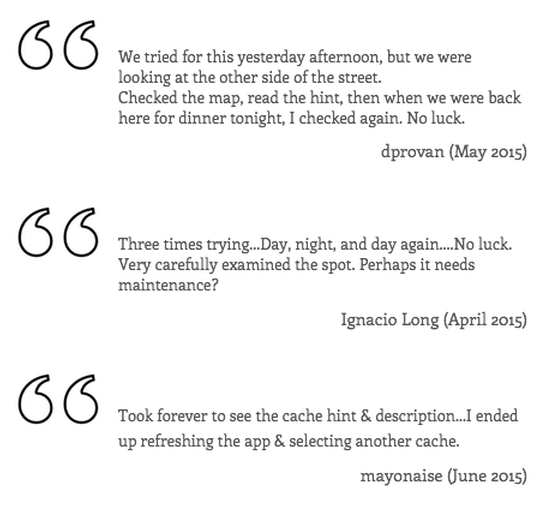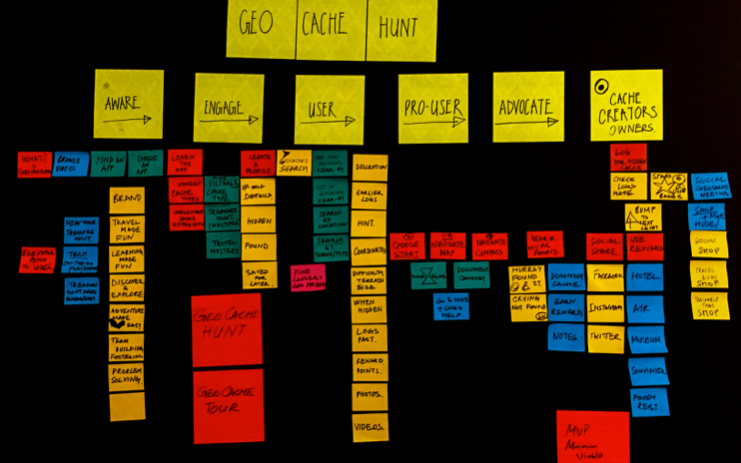
Overview
The Cache Hunt app is a geocaching tool that was created for our client Rand McNally by three designers. Rand McNally, an established business that has been the industry leader of maps, atlases, textbooks & globes for travel, wished to enter the geocaching market that has steadily been gaining popularity in the recent years. In a team collaborative effort, a preliminary design was produced to demonstrate that our client was ready for new market.
My Role
My primary roles were user research, persona creation & usability testing.
Group efforts included prototyping, ideation, and information architecture designs.
The Challenge
Understanding GeoCaching & the Current Market
Our design team, including myself, has never geocached in the past, so we naturally kicked off our initial meeting by discussing our current understanding of geocaching. It was pretty clear from this conversation that we needed to learn as much as we could about geocaching as we knew very little about the activity. We used the web as our primary resource to learn about geocaching. Main websites we visited for more information were Wikipedia, GeoCaching.com, Facebook & OpenCache.com. We also visited our client's website to gain understanding of their current product lines & services that they offer to see where they may fit in the geocaching market. Three popular apps in the geocaching community were identified: GeoCaching, GeoSphere & GeoBucket.
Competitive Analysis
Our team ran a competitive analysis of these three apps and found that there were many similarities in the app design, the overall process flow and the features. We also compared the business & pricing model for further analysis.

The Process
Contextual Inquiry: Learn by Doing
The approach we took after getting familiarized with geocaching and some of the popular apps, we hit the road with these apps installed on our devices. We used the GeoCaching app as our primary guide tool and tried to locate a specific cache that was hidden close to our office. Although the GeoCaching app was the easiest tool to use to navigate around, we still had a difficult time locating the hidden item. We wished that some level of hints were readily available in the app while we were looking, and it took us over one hour to locate the item. We later learned that additional hints were available, but with some learning curve combined with no hints, our exercise to locate the cache became confusing & unenjoyable.
Discoveries
-
Engaging & fun solo activity
-
Fun group activity
-
Great way to explore a new surrounding
-
Good way to meet someone new
-
Good way to maintain a relationship with fellow geocacher
Opportunities
-
Existing apps are outdated and feel clunky to use
-
Overall learning curve is steep
-
Some apps are slow to load data
-
Inaccurate map & compass tools found on some apps
-
Basic features are unavailable on some free versions
Our Vision: Focus on User Goals (and not on features)
Our goal after exploring exisiting geocaching tools was fairly simple; Minimize the negative experience that was brought on by inadequately designed tools while ensuring that the design we produced maximized the positive geocaching experience.
In addition to creating a well designed geocaching tool to add to the current catalog of products & services at Rand McNally, we also wanted to make it a meaningful tool for current & future users by amplifying the learning experience of geocaching. We felt that combining the educational concept with exisiting process & technology at Rand McNally, our vision to amplify the learning aspect of geocaching could easily be achieved.

Interview & Data Collection
Our user research started with a face-to-face interview with an experienced geocacher. From this interview, we were able to visualize her geocaching journey that she typically takes with her family. My main takeaway from this interview, aside from getting to know the general geocaching process, was that geocaching is a fun pastime activity.
We were also able to collect useful and relevant information from exisiting pool of logs that were made by current users worldwide. Here are some sample logs for our research:
Personas

Negative Feedback From Users

Positive Feedback From Users

User Map

Prototype Design
Cache Hunt: Our Proposed Geocaching App for Rand McNally
Based on our discoveries and research, our design team put our heads together and produced a preliminary design for the geocaching app. Below is a collection of work-in-progress view of the app, and it highlights the key functionalities of the tool.

The Refinement
Usability Testing Feedback
-
Unsure as to which option to select for login
-
Unsure of what some of the global elements mean
-
Unsure of terminology (Popular, Recommended, GeoTour)
-
Participants prefer map view over list view
-
Process of choosing the cache tour is confusing
-
Unsure of when & where to look for detailed information prior to committing to a specific tour.
-
Text directions along with the map guide would be helpful
-
The distance data is unclear
-
Participants unsure of different symbols
Reflections
Lessons Learned
I'm proud of the work that we did to produce our content and prototype for this design project in just two week timeframe. Starting with three designers who knew nothing about geocaching to creating a prototype tool that helps users learn and have fun in the real world is a big accomplishment in my humble opinion. This project not only has taught me a good deal about critical thinking in producing a well designed product, but it has also taught me the value of working together with other collaborators to achieve the same goal. We shared the frustrations of using & learning badly designed apps on day one to maintaining teamwork until the final presentation was delivered at the end of week two.
I'm also pleased with how quickly we were able to gain knowledge about this popular activity & make solid traction with our approach to helping Rand McNally enter the geocaching market. Based on our research, there are no geocaching apps that are specifically designed as a learning tool, so our recommendation for Rand McNally to create a niche within the market for themselves became a clearer message: 1) create a learning channel for those who want to geocache as a educational mechanism and 2) incorporate geocaching as a discovery aid in their immediate environment, whether while traveling in new places or discovering new things about where you live. Achieving these tasks for them would not be difficult as they already have extensive lines of products & services, and they can leverage on their existing technology to make a robust tool.
Warm regards and thanks for reading!